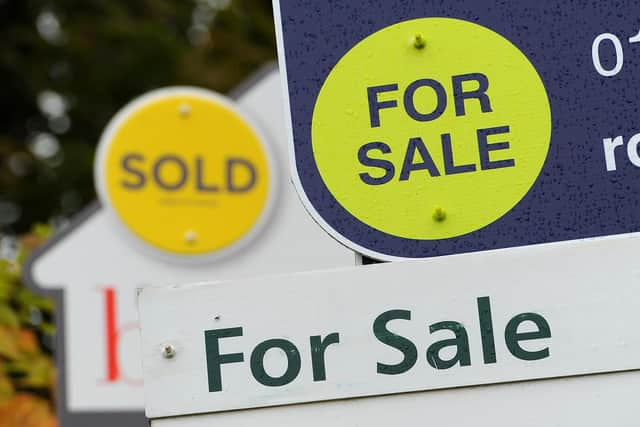Scottish house prices soar by a over a quarter since start of pandemic
The affordability crisis in Scotland’s housing market looks to have intensified since the start of the pandemic after new figures indicated that average house prices across the nation have risen by over a quarter since the first lockdown was put in place.
Research carried out by one of Scotland’s leading property firms found that nationwide, average prices jumped 27.4 per cent between March 2020 and July this year, with an even more pronounced spike recorded in the nation’s largest city, where escalating prices continue to make it extremely difficult for first time buyers looking to enter the market.
Advertisement
Hide AdAdvertisement
Hide AdAccording to DJ Alexander, the largest estate and letting agents in Scotland, the nationwide increase outstripped the 8.9 per cent growth recorded in the 40 months prior to the pandemic. The firm described the increases seen over the past three years as “enormous,” but stressed it was unlikely such a rate of growth could be sustained in the long-term.
Other research published in recent months suggests that trend has already reversed, with some property experts reporting the first fall in the price of buying a home in Scotland since the market was disrupted by Covid-19.
The figures released by DJ Alexander show that since the pandemic began, the rise in prices in Glasgow have outstripped the vast majority of other parts of the country. Average prices rose by 33.5 per cent since March 2020, up from £133,366 to £178,108. That compares to an increase of 14.2 per cent recorded between December 2016 and March 2020.
Edinburgh also saw an increase in prices in the 40 months since the start of the pandemic, although at 21.4 per cent, it was lower than both the national average over the same period, and the 21.9 per cent jump seen in the capital between December 2016 and March 2020. Aberdeen also recorded a 21.4 per cent increase in prices since the beginning of the pandemic, compared to an increase of just 2.2 per cent in the preceding 40 months.
David Alexander, chief executive of DJ Alexander, said: “These figures show that, despite media concerns that house price increases have slowed in recent months this is actually because they have risen at such an enormous rate since the start of the pandemic. Even without higher interest rates there would have to be a slowing of house prices simply because they have been rising at an unusually high pace.


“The previous 40-month period shows an increase of 8.9 per cent which is much more in line with historic trends. However, these figures also reveal that both Glasgow and Edinburgh have been experiencing much greater price growth than the rest of Scotland for the last seven years indicating demand for these cities is far exceeding supply.”
However, other cities have seen a decline in their average house price, the figures show. In the 40 months since the pandemic began, prices in Dundee dipped from £141,192 to £138,110, a decrease of 2.2 per cent. Prices in the city fell at an even sharper rate of 15.8 per cent between December 2016 and March 2020, according to DJ Alexander.
In a sign that more homeowners are turning to more affordable rural areas and commuting hotspots near major cities, Mr Alexander pointed to a “ripple effect” seen in local authority areas around Edinburgh. East Lothian recorded an “astonishing” 59.7 per cent rise in average prices over the past 40 months, with Fife (31.2 per cent) and West Lothian (29.1 per cent) also seeing increases greater than the Scottish average.
Advertisement
Hide AdAdvertisement
Hide Ad“These were popular areas prior to the pandemic but the desire to live more rurally, with more outdoor space, coupled with easy access to the city is driving prices in these areas to extremely high levels,” he said.
However, Mr Alexander expressed doubt that the increases seen over the past 40 months would continue indefinitely, explaining: “There must come a point at which affordability issues kick in with average prices already substantially higher than they were even a few years ago.
“The high levels of employment coupled with rising interest rates means that many homeowners are still able to afford to buy the home of their dreams. There will be a stabilising of prices and a return to lower annual increases, but we may not be at that point just yet and some parts of Scotland remain extremely popular.”
The latest analysis as part of Halifax’s house price index, released in September, showed that the average Scottish house prices were down 0.8 per cent on the previous year, with UK prices falling at an even steeper rate of 4.7 per cent. Across the UK, there have now been six consecutive monthly falls in the average house price, according to the index.
Other research indicates that the ongoing cost of living crisis and rising mortgage rates are combing to exert a similar toll on prices. Another leading firm, Nationwide, reported an even steeper drop in average house prices across the UK of 5.3 per cent in the year to September, with a slightly less pronounced decrease of 4.2 per cent in Scotland.
According to the property website, Zoopla, discounts on asking prices for homes across the UK are now at a level not seen since March 2019, with buyers typically getting 4.2 per cent shaved off a property's asking price.
Comments
Want to join the conversation? Please or to comment on this article.